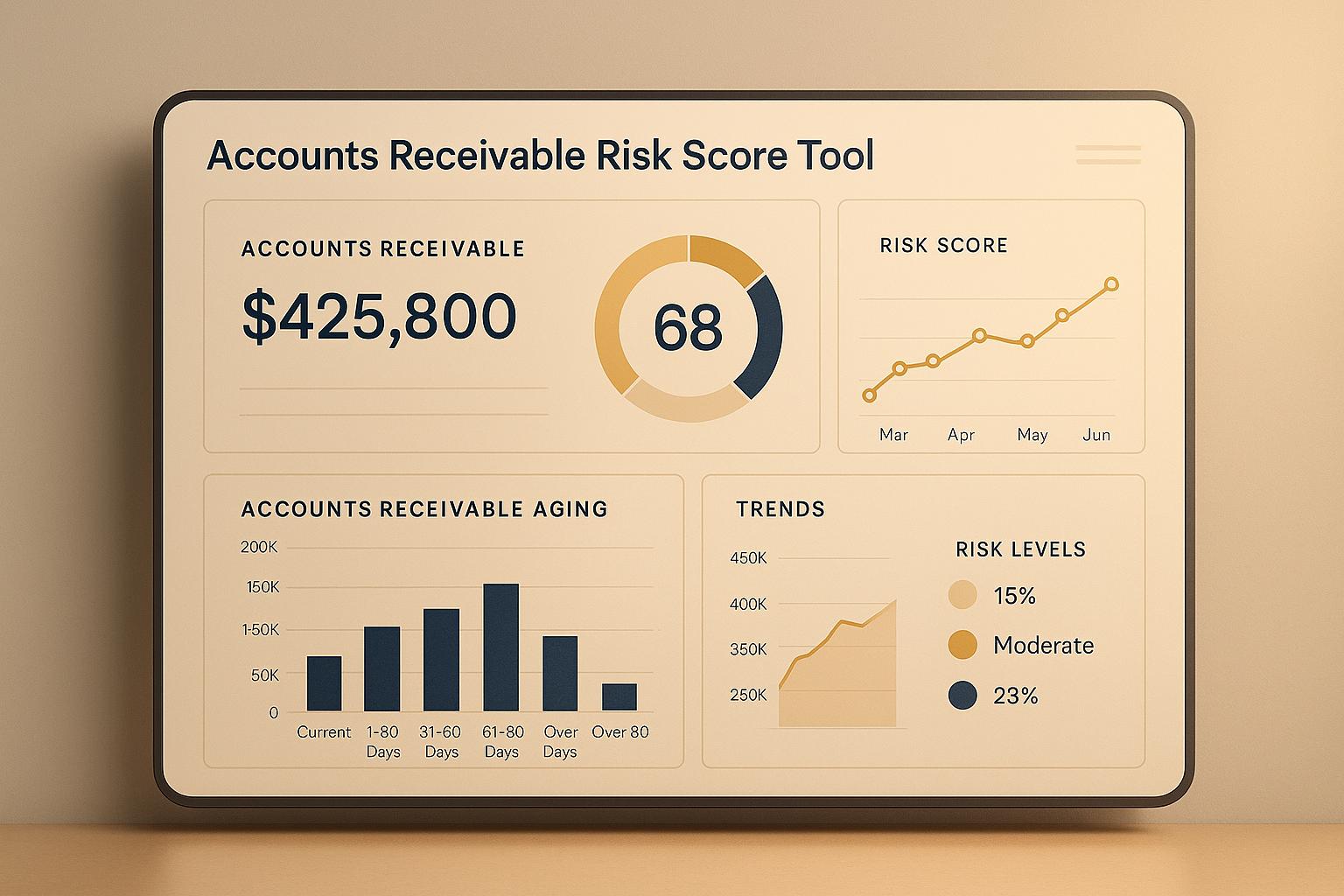Risk assessments are the backbone of setting customized premiums for trade credit insurance. Insurers analyze a business’s specific risks – like customer financial health, industry stability, and geographic factors – to determine fair pricing. This ensures that businesses with lower risks pay less, while higher-risk companies face higher premiums.
Key factors influencing premiums include:
- Customer financial health: Stable, diverse customer bases lower costs; reliance on a few risky clients increases them.
- Industry risks: Volatile sectors like construction or manufacturing often face higher premiums.
- Profit margins: Slim margins mean higher risks and costs.
- Geographic and regulatory factors: Operating in multiple regions or unstable markets can raise premiums.
- Payment history: A strong track record can help offset past challenges.
Insurers use detailed data collection, market trend analysis, and ongoing monitoring to fine-tune policies. Businesses can lower premiums by sharing accurate data, showcasing strong credit practices, and working with professional risk assessment services. These services help align policies with actual risks, offering tailored coverage for domestic and international operations.
What Is Risk Assessment In Insurance? – The Friendly Statistician
What Risk Assessments Cover in Trade Credit Insurance
Risk assessments play a crucial role in determining premiums for trade credit insurance. By looking beyond basic credit scores, insurers dive into the financial details of a business to create tailored pricing.
Main Factors That Affect Premium Calculations
One of the biggest drivers of premium costs is customer financial health. Insurers evaluate the creditworthiness of a company’s customers and analyze how concentrated the business is on specific clients. Companies with a broad base of financially stable customers often enjoy lower premiums. On the other hand, businesses that rely heavily on a few customers – especially those with financial challenges – are likely to face higher costs.
Industry stability also impacts premiums. Sectors prone to unpredictable demand or historical risks tend to see higher insurance costs. For example, industries with volatile cycles or frequent downturns are considered higher risk.
Another key factor is profit margins. Industries with slim margins typically face higher premiums since their financial buffer against losses is smaller. For instance, manufacturing sectors with tight profit margins often pay more for coverage compared to industries with healthier margins.
Geographic and regulatory factors add complexity to the equation. Insurers carefully consider the regulatory environment in which a company operates, as changes in regulations can affect customer payment behaviors. Businesses operating in multiple regions may see their risks aggregated across all markets, which can influence premium rates.
Finally, historical payment patterns provide valuable insights. Insurers review a company’s track record of late payments or defaults, as well as trends within the broader industry. Even if a business has struggled with receivables in the past, a positive market outlook or strong anticipated demand for its products can sometimes help balance the scales.
These factors come together to form a detailed picture of risk, which is then used to determine premiums.
How Insurance Companies Perform Risk Assessments
Once the key risk factors are identified, insurers follow a structured process to evaluate them.
The first step involves data collection. This includes gathering financial statements, customer payment histories, industry reports, and market data. Insurers cross-check this information with external databases and credit agencies to ensure accuracy and flag any potential concerns.
Next, market trend analysis becomes a critical part of the evaluation. Insurers look at the industry’s current outlook and future demand for products or services. This forward-looking approach helps them price policies based on anticipated risks rather than relying solely on past performance.
Insurers also use ongoing monitoring tools to track risks over time. Even after a policy is in place, they continue to monitor customer health, shifts in the industry, and regulatory updates. This allows for timely adjustments to premiums if risks evolve.
How Premiums Match Business Risk Levels
Insurance premiums are carefully adjusted to reflect the specific risk levels of each business. This approach ensures that businesses with lower risks enjoy lower premiums, while those with higher risks pay more. Let’s take a closer look at how different industries influence these premium variations. These differences arise from detailed risk evaluations that form the foundation of every insurance policy.
How Different Industries Affect Premium Rates
Industries with higher risks – such as construction, manufacturing, transportation, and restaurants – tend to face steeper premiums due to the increased likelihood of defaults and challenges tied to market instability. For instance, in construction, the nature of project-based work combined with irregular payment schedules significantly raises the risk of default. Similarly, manufacturers often operate on tight profit margins, leaving them vulnerable to delays caused by supply chain disruptions.
Seasonal trends and market unpredictability also contribute to heightened risk, which translates to higher premiums for businesses in these sectors.
On the other hand, industries with lower risk profiles – like consulting firms and IT service providers – usually benefit from reduced premiums. These businesses often operate in stable markets with steady cash flows and minimal default risks. Additionally, companies that rely heavily on a single high-risk industry may face higher premiums compared to those that spread their customer base across multiple, more predictable sectors.
Interestingly, a favorable market outlook can help balance out past difficulties. When future demand looks strong, it can ease the pressure of premium increases.
sbb-itb-2d170b0
Getting Better Premiums Through Professional Risk Assessment Services
Specialized trade credit insurers can help businesses secure lower premiums by conducting detailed risk evaluations. These professionals bring a wealth of knowledge in assessing business risks and aligning them with coverage options that accurately reflect your specific risk profile, rather than relying on broad industry averages.
By analyzing factors like customer profiles, payment histories, industry exposure, and geographic risks, professional risk assessment services can pinpoint opportunities to reduce premiums. This level of detail often uncovers savings that might be overlooked when working directly with insurance carriers.
Accounts Receivable Insurance takes it a step further by tailoring policies based on trade relationships, customer creditworthiness, and market exposure. This approach ensures businesses receive competitive premiums that align with their actual risk levels.
The real advantage of using professional services lies in their ability to effectively present your business case to insurers. They know how to emphasize risk mitigation strategies, strong customer partnerships, and effective credit management practices – factors that can justify lower premium rates. This expertise is particularly crucial for businesses with complex or unique risk profiles that don’t fit neatly into standard underwriting categories. Their precise risk analysis enables the creation of customized policies for both domestic and international markets.
Custom Policies for US and International Business
Professional risk assessments pave the way for policies tailored to address the specific challenges of both domestic and global trade. Accounts Receivable Insurance develops policies that cater to the unique risks faced by businesses operating in the US and those engaging in international markets.
For US-based businesses, customization considers factors such as regional economic conditions, industry concentration in certain states, and the regulatory landscape affecting customers. For instance, a tech company serving clients in Silicon Valley faces entirely different risks than a manufacturer working with customers across the Midwest. These distinctions are carefully factored into policy design.
When it comes to international trade, the complexity increases. Accounts Receivable Insurance evaluates country-specific risks like political instability, currency fluctuations, and differing legal systems for debt recovery. They also assess risks tied to government actions or currency controls that could block payments.
Policy terms and coverage limits are adjusted to match your specific trade patterns. For example, a company exporting primarily to established European markets will likely receive different terms than one focused on emerging markets in Asia or Latin America. This targeted approach ensures you’re only paying for the coverage you need, while still being adequately protected against real risks.
Additionally, Accounts Receivable Insurance provides access to a global network of credit insurance carriers. Each carrier has its own appetite for certain types of risk, and professional brokers can identify which carriers are most likely to offer favorable terms for your situation. This global reach ensures you get competitive rates tailored to your unique risk profile.
Continued Support and Claims Handling
The benefits of working with professional services don’t stop at policy setup. Ongoing support ensures that your premiums remain competitive over time. Accounts Receivable Insurance continuously monitors risks, adjusting coverage as your business evolves, your customer base changes, or market conditions shift.
Regular policy reviews ensure your coverage stays aligned with current risks. Whether your business grows, changes its credit terms, or enters new markets, professional providers adapt your policies to reflect these changes.
Claims management is another area where these services shine. Accounts Receivable Insurance handles the entire claims process, from filing to resolution, ensuring quick processing and favorable settlements. Their expertise helps avoid delays and maximizes the efficiency of claims handling.
Claims data also plays a key role in refining risk assessments and optimizing premiums. By analyzing patterns in claims, professional providers can identify trends that might affect future coverage or premium rates. This data-driven approach often leads to better rates during policy renewals.
In addition, pre-claim interventions are a proactive service offered by Accounts Receivable Insurance. They work to resolve payment disputes before they escalate into formal claims. Not only does this help maintain strong customer relationships, but it also demonstrates effective risk management to insurance carriers – potentially leading to better premium terms in the future.
When it’s time for policy renewal, professional providers use their deep relationships with carriers and thorough understanding of your business to negotiate favorable terms. They also identify opportunities for premium reductions based on improved risk factors or a positive claims history. This ongoing support ensures your business continues to receive competitive rates while staying protected.
Best Practices for Businesses
To get the most out of your insurance coverage, it’s essential to share accurate financial and customer data with your insurer. Keeping your financial records and customer information well-organized allows for precise risk evaluations and can even reveal opportunities to lower your premiums. As mentioned earlier, accurate risk assessments lead to personalized premium rates, and your proactive documentation plays a big role in achieving this.
Showcase your credit policies and collection practices. Insurers appreciate businesses with strong internal controls and a proactive approach to risk management. This includes documenting your credit approval processes, payment terms, collection methods, and any credit monitoring tools you use. A systematic, well-documented approach makes your business more appealing to underwriters by presenting a solid risk profile.
Consider holding quarterly reviews with your insurer to discuss changes in customer demographics, market expansions, or shifts in your industry. These check-ins can help identify when adjustments to your policy might lead to better premium rates. Staying on top of these updates ensures your risk profile remains aligned with the tailored premium strategies discussed earlier.
How to Get the Most from Customized Premiums
When working with customized policies, the key is to provide complete and accurate information during the initial risk assessment. Share details about your strongest customer relationships, your longest-standing accounts, and any strategies you’ve implemented to diversify and reduce concentration risk.
Collaborate closely with Accounts Receivable Insurance to ensure your policy reflects your business’s actual performance. For instance, if a significant portion of your revenue comes from customers with excellent credit ratings, make sure this is factored into your risk assessment. Likewise, if you’ve had success collecting payments from customers in challenging markets, document and share these achievements to highlight your collection capabilities.
Track your claims ratio and document successful debt recoveries to support premium reductions during renewal periods. Keep records of resolved customer disputes, negotiated payment plans, and any proactive steps you’ve taken to avoid potential losses. These demonstrate effective risk management and can positively influence your premiums.
Additionally, reporting your proactive dispute resolution efforts to your insurer shows that you’re committed to minimizing risks, which helps maintain a clean claims history and strengthens your position during renewals.
Review your coverage annually to ensure it aligns with your business’s current risks. As your company evolves – whether through growth or changes in your customer base – you may qualify for better rates or require adjusted coverage limits. Regular reviews with your Accounts Receivable Insurance provider can help you identify cost-saving opportunities and avoid paying for coverage you no longer need.
Finally, stay informed about market trends and conditions that impact your customers and industries. Sharing updates about improvements in your customers’ financial health or positive changes in your key markets can strengthen your case for premium reductions. This proactive communication not only supports potential savings but also fosters a stronger relationship with your insurance provider.
FAQs
How do risk assessments help businesses lower trade credit insurance premiums?
Risk assessments are essential when it comes to setting and adjusting trade credit insurance premiums. By evaluating potential financial risks – like customer insolvency, non-payment, or even political upheaval – businesses can pinpoint their specific weak spots and take steps to address them before problems arise.
This kind of detailed evaluation doesn’t just help businesses get coverage that fits their needs; it can also result in lower premiums. How? By showing insurers that the business has actively worked to reduce its risk. With the right expert advice and tailored policies, companies can safeguard their cash flow and tackle unique challenges, whether they operate locally or on a global scale.
How can businesses improve their risk profile to lower trade credit insurance premiums?
Businesses looking to improve their risk profile and potentially reduce trade credit insurance premiums can take a few practical steps. One key strategy is to monitor risks in real-time, enabling swift responses to emerging issues and adjustments to credit terms when necessary. Another smart move is diversifying the customer base, which helps spread risk and reduces dependence on clients with higher financial uncertainty. At the same time, building stronger relationships with dependable customers can encourage consistent payment habits, creating a more stable financial environment.
Customizing insurance policies is another way to better align coverage with specific business needs. For instance, opting for higher deductibles can lower premium costs by limiting the insurer’s financial exposure. By adopting these strategies, companies can better manage their risks and negotiate insurance terms that address their unique circumstances.
How do location and regulations impact trade credit insurance premiums for international businesses?
Trade credit insurance premiums are shaped by a mix of geographic and regulatory elements. Insurers closely examine regional risks, such as political unrest, economic instability, or exposure to natural disasters. These factors can differ widely from one country to another, meaning businesses in higher-risk areas often pay more for coverage to address these added uncertainties.
Local regulations are another critical piece of the puzzle. Shifts in laws, underwriting practices, or coverage mandates can significantly impact how insurers evaluate risk, sometimes leading to higher premiums. For example, stricter legal requirements in certain countries may demand more comprehensive policies, which, in turn, can increase costs. By staying informed about these dynamics, businesses can better navigate global markets and secure insurance solutions tailored to their specific needs.




